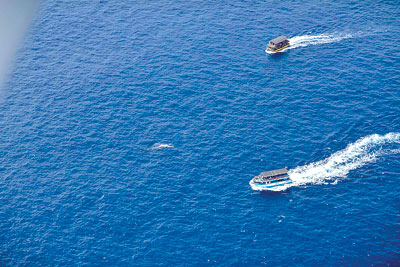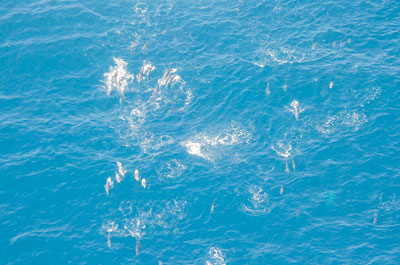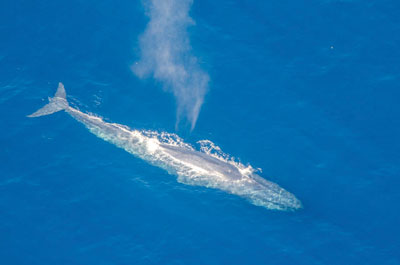Whales from above: Memory of a lifetime
View(s):KOGGALA – F-Airways (F-Air)’s three aircraft are parked and ready for take-off at the Sri Lanka Airforce base at Koggala.

Boats chasing a whale
Guests preparing to take-off on the 4-seater Cessna 172 aircraft are welcomed with a chilled drink and check-in at a comfortable lounge bordering a lake at the tail-end of the runway.
Flight
As we are cleared by the control tower with a ‘thank you’ response from pilot captain Kosala Premachandra, my expectations are running as high as the blue skies on the journey ahead. “Hope you see as many whales as possible,” jokes Sanjay Adhikari, Chief Executive Officer (CEO) at F-Air, the other passenger on the flight, adding further: “This is like an affordable tuk-tuk in the air.”
Whale-watching-by-air is a new concept in Sri Lanka with F-Air promoting “air tourism’ on the lines of a New Zealand Tourism product. Whale and Dolphin Watching Regulations and Guidelines are strictly followed by the company like for instance flying above 1000 feet before coming down to 700 feet when a mammal is spotted.
Ambience
The Cessna takes us over picturesque scenes like temples, lakes, mountain ranges and the Weligama Bay which has the lovely Cape Weligama by Dilmah resort perched on a small hill abutting the beach. Part of this exercise is to show guests other places of beauty.
Whales are generally located between 5 to 15 nautical miles (8 to 25 km) off the coast and as we fly overhead amidst a cluster of tourist boats below – also on the same whale-watching expedition – we spot a blue whale. The boats are closing in like a race, the fastest to get there gets the best (camera) shot. We drop down to 700 feet and clearly see a large, majestic blue whale squirting water as it breathes on the surface of the water. As everyone up and down scramble for their long-range cameras, another one is spotted and something strange could be seen trailing the whale. The line of large red spots is in fact whale poo.
Then at different times, single and whales moving in groups are spotted or breaking away probably due to the sounds, gliding through the turquoise blue waters. It’s easier to see them from the top as small aircrafts are less noisy than boats. As a boat nears one, the whale takes a huge dive and sinks into the ocean without a trace. Sanjaya says it would take 10 to 15 minutes for that creature to surface again because it dives to the depth of the ocean before rising.
Breathtaking views
The sight from above and at 500-700 feet is breathtaking and hard to describe. As the Cessna moves away from the whales, we spot a group of dolphins, a pod of 10 to 15 pilot whales three to four turtles and a group of wind surfers having fun, ending a magical 45-minute, savour-for-life ride.
Logistics

Dolphins
F-Air operates tours mostly at the weekend but handles special tours on requests from resorts for their guests. It has three Cessna’s with two more due in May-September. The company operates an average of 6-8 whale watching flights per day.
The company also helps in data collection by researchers studying blue whales, at 30 metres in length and 180 metric tons or more in weight, it is the largest known animal to have ever existed. F-Air plans to fix a camera on the underbelly of the aircraft to help marine biologists research whale movements.
Ticket per passenger costs US$150 each and $100 for those between 3-14 years. The company also offers package tours to 16 other scenic areas in Sri Lanka and for research purposes on a per-passenger rate or flat rate (for the full aircraft) of $300 per hour.

Whale of a time! - A large whale off the shores of Galle. Picture courtesy F-Airways (F-Air)
| What better way of watching blue whales than from a low-flying small aircraft off Sri Lanka’s picturesque southern coast. During a 45-minute flight from Koggala Airport, off the coastal town of Galle, Business Times Editor Feizal Samath sees dozens of blue whales and dolphins in a ‘memory of a lifetime’ journey. | |


